I think it is fairly well established that I love the Arts for Transit program, and pretty much any transit-related art in general. My three-year-long jaunt to every single Metro-North station was not only a great way to become familiar with our rail system, but to also become familiar with the art found within many of the stations. The Hudson Line has some of the newest and most attractive pieces out of the Arts for Transit program, including two stations that never made it into my Tuesday Tours. Both Croton-Harmon and Peekskill got some art in the latter half of 2012, after both stations had been featured on the site. Both are rather attractive designs, and I figured it would be worth visiting the Hudson yet again to check them out.
Some of Arts for Transit’s most successful installations are those that almost transcend the barrier between art and function, and those that interact with the space in which they are placed. While bronze sculptures hanging on the wall are certainly a lovely (though easily missed) addition to any station, the bronze chairs you’ll find at Pleasantville station become even more than that. They are attractive, but also functional, they interact with the people that use the station, and they begin a dialogue. People that spy them from the train might say, “what are those nice looking chairs, and why are they there?” And as the artists intended, they evoke the comforts and feelings of home, and the thought that to many regular commuters this station is their second home. When comparing Arts for Transit pieces, Pleasantville always seems to be the bar to which I compare, and is (at least in my opinion) one of the best embodiments of the program’s concept of enhancing the experience of travel.
In a similar vein to the Pleasantville piece, both of the newest Arts for Transit works on the Hudson Line seem to interact with the stations in which they’ve been placed, and thus the people that frequent them. Croton-Harmon’s artwork, a series of laminated glass panels by Brooklyn-based artist Corinne Ulmann, not only depict the changing of seasons, but seem to change on their own based upon the light that filters into the overpass. Several Hudson Line stations feature both faceted and laminated glass works in the overpasses, and I’ve always felt they’ve been successful as they’re never the same at all times. As sunlight passes through, colors are reflected onto the platforms and walkways and move as the sun crosses the sky. Thus the art is hardly static, it subtly changes due to season, time, and weather.
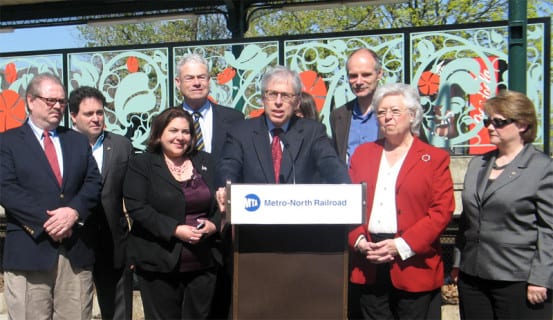
Metro North President Howard Permut speaks at Peekskill, with the station’s newest Arts for Transit piece in the background. [image credit]
Peekskill’s art, an installation of various painted steel pieces by Joy Taylor, also interacts with the station, and the sunlight. The large pieces cast shadows on the platform, but also highlight a play between new and old at the station. During Peekskill’s recent renovations, the station’s historical canopy was restored. This canopy runs parallel to the more modern one found on the station’s other platform, but both evoke a different feeling. The historical canopy is rounded, where the new is more angular, with squared edges. But with the artistic flourishes added to the modern canopy (the historical canopy was appropriately left without embellishments), the new canopy visually parallels the old. Not only does it create an interesting play between new and old, but it emphasizes the historical nature of the one canopy. That side of the platform is not bare, however. The fencing behind the old canopy carries the same flowery motif, but without compromising the part that is historical.
If you happen to get over to the Hudson Line, both pieces are certainly worth checking out, and make commuting on the Hudson Line a little bit more attractive than before.
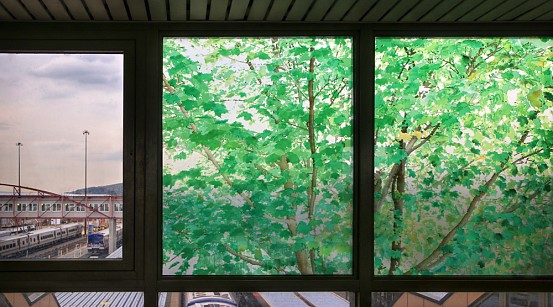 Â
 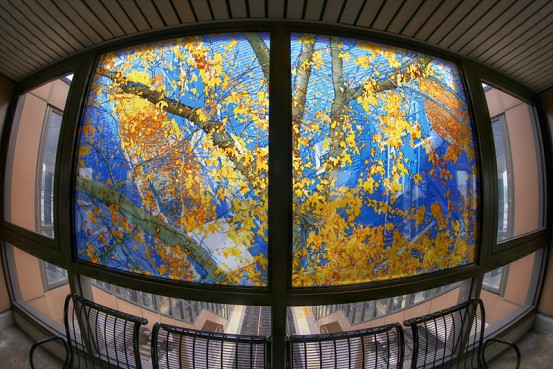 Â
 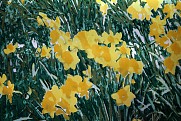 Â
 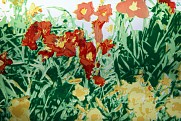 Â
 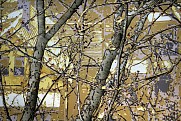 Â
 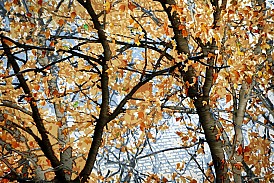 Â
 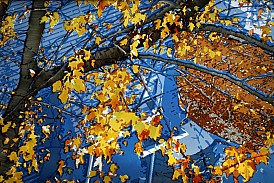 Â
 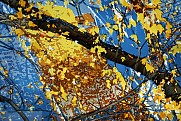 Â
 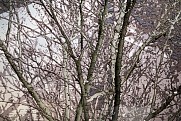 Â
 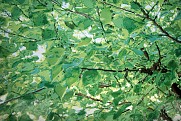 Â
 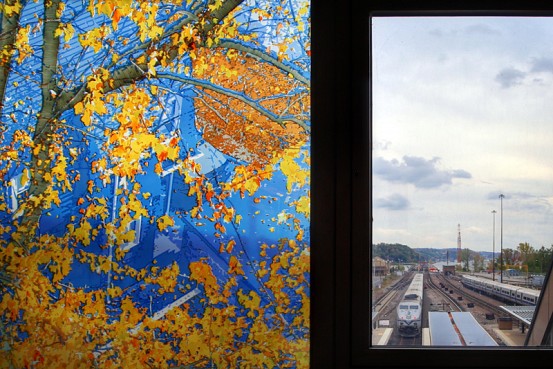 Â
 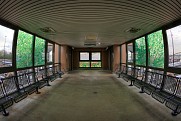 Â
 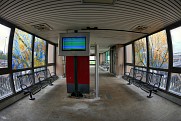 Â
 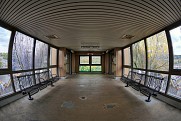 Â
 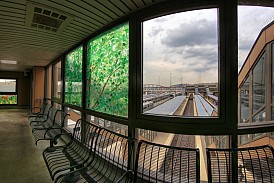 Â
 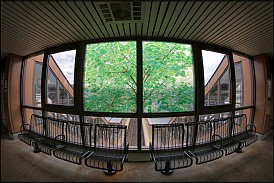 Â
 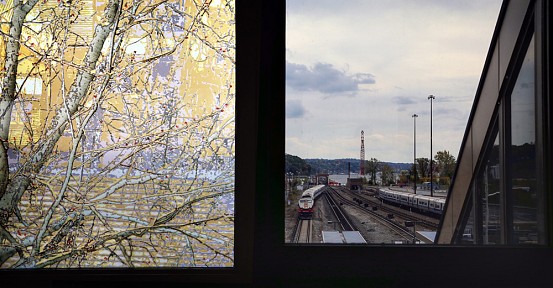 Â
 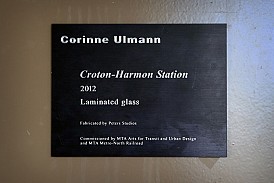 Â
 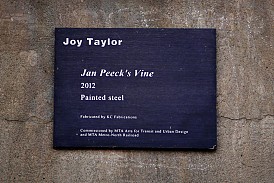 Â
 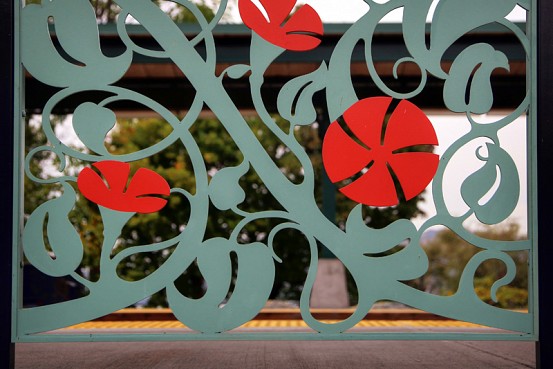 Â
 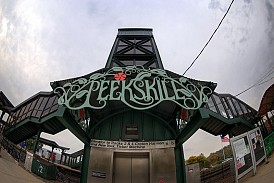 Â
 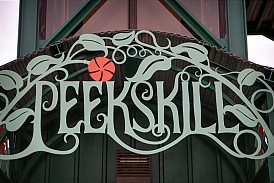 Â
 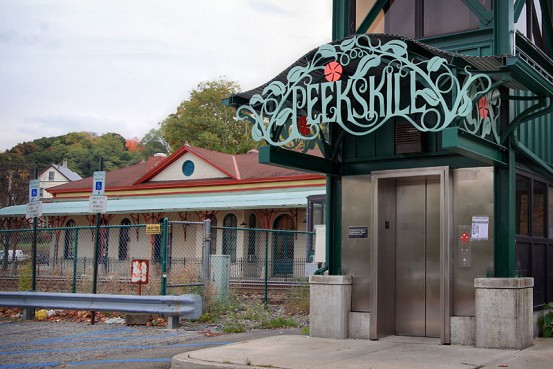 Â
 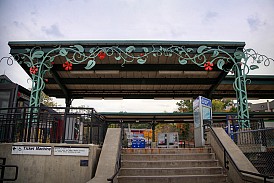 Â
 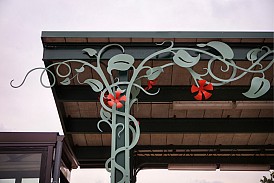 Â
 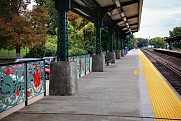 Â
 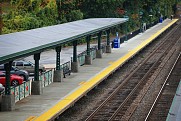 Â
 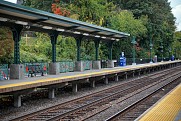 Â
 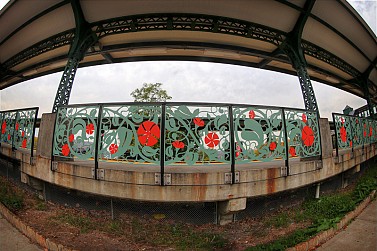 Â
 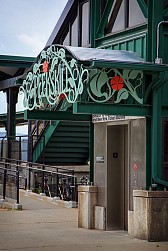 Â
 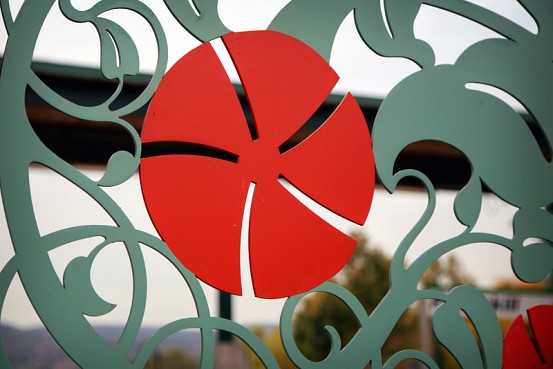 Â
 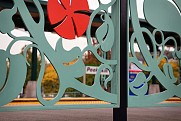 Â
 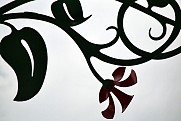 Â
 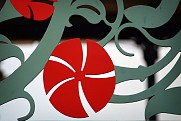
And before I forget, Metro-North’s newest Arts for Transit will be at Fordham station on the Harlem Line. If you happen to be an artist, you still have a few days to reply to the Call for Artists. Submissions need to be postmarked by the 28th.


With Metro North considering revival of the East Bronx (formally known as the New Haven Harlem River Line, it might be interesting to see the remains of some of the old stations.
The New Haven stopped this local service in the mid ’30s. Some were quite decrepid in the Mid ’50s (Westchester Ave), still in use (Hunts Point), or barely recgonizable (Van Nest). Another station which served as a model train club in the ’50s was Pelham Manor (it may have been torn down when the New England Thruway was built)
Have you ever viewed transit art in other systems?
SEPTA in Philadelphia has an arts program:
http://www.septa.org/art-in-transit/
On NJ Transit’s River Line, there is an artistic plaque at each station with an image portraying the neighborhood history.
Some legacy carriers installed artwork in their stations. On the Newark City Subway, there are tileworks describing life on the Morris Canal; these are done in a 1930s style. In Newark-Penn station there are bas relief of various transportation scenes.
On the PRR’s Levittown PA commuter station, built in the early 1950s, they used slanted pillars and roof, representative of the modern architecture of that era. Some old PRR stations on the Chestnut Hill West line have whimsical woodwork.
I’ve covered the art on Minneapolis light rail a bit here, and will be doing a few future posts about Denver, but I haven’t gotten a chance to do SEPTA. There are a lot of really cool transit art projects out there!
Here are a few images of legacy art:
Pennsylvania Railroad:
–Statue to remember the fallen of World War II at 30th Street Station
http://www.nycsubway.org/perl/show?100678
–Grillwork embedded with PRR logo at 30th Street Station
http://www.nycsubway.org/perl/show?100677
–Decorative woodwork, Allen Lane station
http://www.nycsubway.org/perl/show?113850
Newark City Subway–station murals (1930s WPA style)
http://www.nycsubway.org/perl/show?27688
http://www.nycsubway.org/perl/show?27690
Peekskill, with the Art Nouveau/Jugendstil-type ornamentation, is sort of reminiscent of the Paris Metro. You don’t see an awful lot of AN/J in the US, except perhaps for Louis Comfort Tiffany. And what LCT said about art in general goes for the decorative aspects of a public transportation structure:
“True art is ever progressive, and impatient of fixed rules. Because a thing has always been done in a certain way, is no reason why it should never be done in any other.”